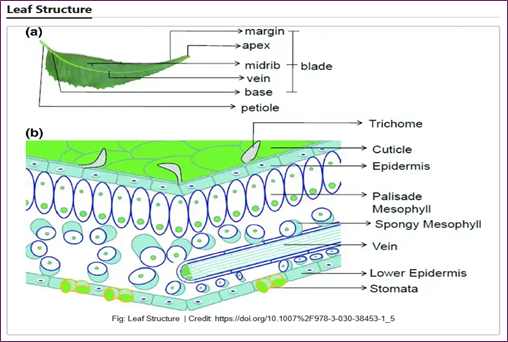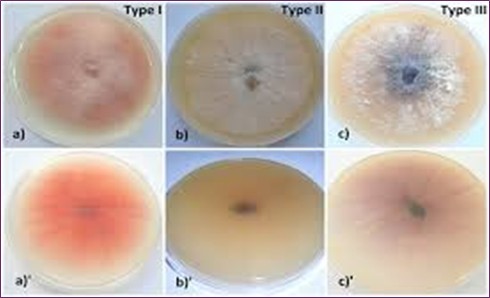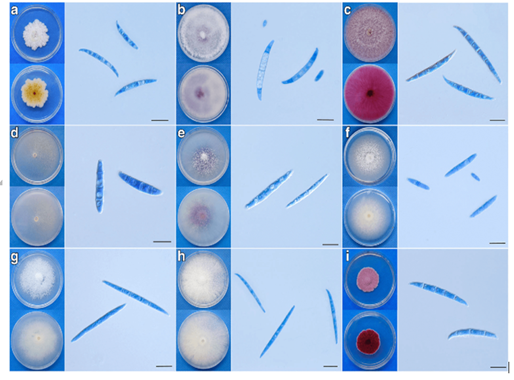Research Article
How Does Fusarium Affect Castor Plants
- Hamid kheyrodin
Corresponding author: Hamid Kheyrodin, Assistant Professor, Semnan university-Iran.
Volume: 2
Issue: 3
Article Information
Article Type : Research Article
Citation : Hamid kheyrodin. How Does Fusarium Affect Castor Plants. Journal of Medicine Care and Health Review 2(3). https://doi.org/10.61615/JMCHR/2025/SEPT027140902
Copyright: © 2025 Hamid Kheyrodin. This is an open-access article distributed under the terms of the Creative Commons Attribution License, which permits unrestricted use, distribution, and reproduction in any medium, provided the original author and source are credited.
DOI: https://doi.org/10.61615/JMCHR/2025/SEPT027140902
Publication History
Received Date
09 Jun ,2025
Accepted Date
20 Jun ,2025
Published Date
02 Sep ,2025
Abstract
Fusarium spp. is a group of soil-borne fungi with many different species. Fusarium is widespread and can infect a range of host crops. Many species are considered weak pathogens and can only infect wounded or stressed host plants.
Fusarium affects plants by causing various diseases like wilt, root rot, and stem rot, leading to stunting, yellowing, wilting, and eventually death. These effects can significantly reduce crop yields and quality. Fusarium infects plants through the roots, invading the vascular tissue and disrupting water and nutrient transport. Fusarium oxysporum is the species causing vascular wilt. First, the leaves turn yellow and wilt, mostly on one side of the plant. Finally, the whole plant wilts.
Keywords: Fusarium spp., plant vascular diseases
►How Does Fusarium Affect Castor Plants
Hamid kheyrodin1*
1Assistant Professor, Semnan University-Iran.
Introduction
More than 70% of plant diseases can be traced to fungi or fungus-like pathogens that threaten food security [1]. In addition, many fungal pathogens, including Fusarium spp., also produce mycotoxins, which further threaten human and livestock health [2,3]. Fusarium spp. are also important to food safety in crop production, and especially to the production of cereals. The genus Fusarium is one of the most economically important fungi, containing many agronomically important plant pathogens, mycotoxin producers, and opportunistic human pathogens [4]. This large and diverse fungi family breeds these mycotoxins mostly in the field before harvest. Fusarium species adapt to a variety of habitats and, although they have a notable affinity for moderate climates, they contaminate crops all around the world [5]. Consumption of mycotoxin-contaminated grain by humans or animals can cause acute or chronic illness and, in some cases, death. The most toxic and prevalent Fusarium toxins of economic importance include trichothecenes, fumonisins, and zearalenone.
Many Fusarium species are pathogenic to several important crops; two of them, namely, F. graminearum and F. oxysporum, are listed among the ten most important fungal pathogens in plant pathology [6].
heir success as plant pathogens can be attributed to wide host ranges, endophytic infection, and varied modes of survival and dispersal. Representatives occur in virtually all bioclimatic regions of the world in agricultural and natural ecosystems [7]. Also, the emergence of novel fungal pathogens can threaten food production and/or ecological environments. Hence, the successful control of fungal diseases is challenging, as fungi can easily overcome host resistance [8]. Biological control of fungal diseases is one such approach that offers much toward increasing world crop production.
Fusarium wilts, a vascular disease, cause damage to plant leaves by clogging and destroying water-conducting tissues, leading to wilting, yellowing, and eventual browning (necrosis). Specifically, Fusarium spp. colonize the vascular tissues, causing necrosis and brown discoloration of the xylem vessels, a key symptom (Figure 1).

Figure 1: Plant Leaf Structure
Fusarium is a group of widely distributed fungi known primarily as plant pathogens, but they also pose significant health risks to humans. These molds thrive on various substrates, including soil, decaying organic matter, and indoor environments, and can produce a range of allergens and mycotoxins.
Fusarium wilt, caused by the fungus Fusarium oxysporum f. sp. lycopersici, is a major disease affecting tomato plants, leading to significant yield losses and potential plant death. The fungus invades the plant's vascular system, causing discoloration and ultimately wilting, which can be one-sided or affect the entire plant (figure 2).

Figure 2: Fusarium Affects Tomato
Hosts of Fusarium Oxysporum
- Fusarium oxysporum is a soil-borne fungus with a broad host range that includes many economically important and ornamental plants.
- In tomatoes, specific strains (e.g., F. oxysporum f. sp. lycopersici) cause vascular wilt, leading to symptoms such as yellowing, drooping, and plant death.
- In bananas, Fusarium oxysporum f. sp. cubense is responsible for Panama disease, a devastating vascular wilt that historically impacted the Gros Michel cultivar and now threatens Cavendish bananas.
- In chickpeas, F. oxysporum f. sp. ciceris causes Fusarium wilt, which significantly limits production in many chickpea-growing regions.
- Other leguminous crops, cotton, cucurbits, and sweet potatoes are also susceptible to various host-specific strains of Fusarium oxysporum.
- A number of ornamental plants, including tulips, carnations, and orchids, can be affected by different formae speciales of Fusarium oxysporum.
- Additional specialized forms of the pathogen target other hosts such as sugar beet (F. oxysporum f. sp. betae) and date palms, illustrating its extensive host specificity within the species complex.
Symptoms of Fusarium Wilt
- Older leaves typically begin to yellow (chlorosis) before wilting starts
- Wilting usually initiates in older foliage while younger leaves remain green until later stages
- Affected plants often become stunted with a general decline in vigor and eventual collapse
- Cross-sections of infected stems reveal vascular discoloration, showing brown or reddish streaks in the xylem
- Progressive blockage of the xylem by fungal mycelium and spores leads to impaired water and nutrient transport, intensifying the wilting symptoms
- As the disease advances, leaves may become necrotic and drop prematurely, and the overall plant development is significantly disrupted
- Etiology of Fusarium wilt
- Fusarium wilt is a vascular disease caused by soil‐borne fungi in the Fusarium oxysporum species complex, which includes both pathogenic and non‐pathogenic strains. The disease results from host-specific strains (formae speciales) that have evolved to overcome the defense mechanisms of particular plant species.
- Infection begins when fungal spores or mycelia in the soil enter plant roots through wounds or natural openings, then colonize the root cortex and invade the xylem vessels.
- Once inside the xylem, the pathogen multiplies and produces enzymes—such as cellulases and pectinases—that degrade cell walls, leading to the clogging of water and nutrient transport. Fusarium oxysporum forms different asexual spores (microconidia, macroconidia, and chlamydospores), with chlamydospores serving as durable survival structures that enable long-term persistence in soil.
- Environmental factors—including warm temperatures (typically 24°–30°C), high soil moisture, and poor drainage—are critical in enhancing the pathogen’s growth and infection efficiency. Soil properties such as pH and nutrient levels directly influence both the survival of the pathogen and the severity of disease symptoms in the host.
- The genetic variability among Fusarium isolates, often maintained by clonal reproduction and occasional horizontal gene transfer, results in a range of virulence factors that complicate disease management.
- Effective management of Fusarium wilt relies on integrated strategies such as the use of resistant cultivars, crop rotation, soil amendments, and strict sanitation to reduce pathogen inoculum in the field.
Fusarium Isolation Method
Fusarium species can be isolated on Potato Dextrose Agar (PDA) by using several techniques, including plating tissue samples, dilution, and direct isolation. Once isolated, Fusarium colonies are often characterized by their macroscopic features and color, and molecular identification may be employed for further confirmation.
Potato dextrose agar is a versatile growing medium for bacteria and fungi (yeasts and molds). This agar is used for a broad range of fungi, but there are other agars that are more selective for specific types of fungi. These agars include, but are not limited to, malt extract agar and Sabouraud agar (Figure 3)

Figure 3: Fusarium Species can be isolated on Potato Dextrose Agar
Conidiophores are short, single, lateral monophialides in the aerial mycelium, later arranged in densely branched clusters. Macroconidia are fusiform, slightly curved, pointed at the tip, mostly three-septate, basal cells pedicellate, 23-54 x 3-4.5 µm (figure 4).

Figure 4: Fusarium Conidia and Conidiophores
Fusarium proliferatum is one of the most pathogenic Fusarium species on date palm worldwide.
Results
The Following Pathogens can be Distinguished
- Fusarium oxysporum (Fusarium wilt): Many different hosts, potato (Solanum tuberosum), most vegetables and ornamental crops, tomato (Solanum lycopersicum), tulips (Tulipa), chrysanthemum, banana (Musa sp.)
- Fusarium graminearum/Gibberella zeae (Fusarium head blight or scab): Cereals, soybean (Glycine max), tobacco (Nicotiana tabacum), lupine (Lupinus sp.)
- Fusarium sambucinum/Fusarium sulphureum (Dry rot of potato): Potato (Solanum tuberosum)
- Fusarium solani: Members of the Fusarium solani species complex (FSSC) are capable of causing disease in many agriculturally important crops
Conclusions
The Fusarium spp. is one of the most important fungal groups and is significant in the fields of agriculture, medicine, and veterinary science. They have emerged over the past decades as an important cause of diverse plant diseases, opportunistic human and animal pathogens, and mycotoxin producers. Many of the world’s staple food crops are prone to fungal plant pathogens. Furthermore, the loss of economically important crops to these fungal diseases can destabilize the economies of developing nations that depend on export revenues generated to import food grown somewhere else in the world. However, successful disease management strategies are challenging, since fungi can easily develop resistance to various methods of control. Therefore, biological control of fungal diseases has emerged as one of the alternative methods of control and promises much toward increasing world crop production. Thus, we need better disease surveillance, more accurate predictive forecasting, and new disease interventions in order to achieve better disease control and protect our future harvests, thus achieving sustained global food security.
Acknowledgments
We have a lot of information on the director of Semnan University in Iran, the approaches to its control and management. Of this research.
- Tian, B. Xie, J. Fu, Y. Cheng, J. Li, B. Chen, T. Zhao, Y. Gao, Z. Yang, P. Barbetti, M.J. (2020). A cosmopolitan fungal pathogen of dicots adopts an endophytic lifestyle on cereal crops and protects them from major fungal diseases. ISME J. 14(12), 3120–3135.
- Wu, F. (2014). Perspective: Time to face the fungal threat. Nature, 516, S7.
- Ekwomadu, T.I.; Gopane, R.E.; Mwanza, M. (2018). Occurrence of filamentous fungi in maize destined for human consumption in South Africa. Food Sci. Nutr. 6(4), 884–890.
- Ma, L.J. Geiser, D.M. Proctor, R.H. Rooney, A.P. O’Donnell, K. Trail, F. Gardiner, D.M. Manners, J.M., Kazan, K. (2013). Fusarium pathogenomics. Annu. Rev. Microbiol. 67, 399–416.
- Ekwomadu, T.I. (2019). Occurrence and Variation of Fusarium Free and Masked Mycotoxins in Maize from Agriculture Regions of South Africa. Doctoral Dissertation, North-West University, Potchefstroom, South Africa.
- Dean, R. van Kan, J.A.L. Pretorius, Z.A. Hammond-Kosack, K.E. Di Pietro, A. Spanu, P.D. Rudd, J.J. Dickman, M. Kahmann, R. Ellis, J. (2012). The top 10 fungal pathogens in molecular plant pathology. Mol. Plant. Pathol. 13(4), 414–430.
- Burgess, L.W.; Bryden, W.L. (2012). Fusarium: A ubiquitous fungus of global significance. Microbiol. Aust. 33(1), 22–25.
- Rampersad, S.N. (2020), Pathogenomics and Management of Fusarium Diseases in Plants. Pathogens, 9(5), 340.
Download Provisional PDF Here
PDF




p (1).png)




.png)




.png)
